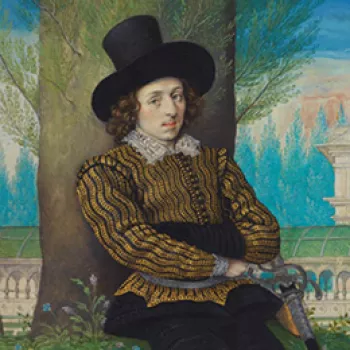Boys among apple trees mid-seventeenth century
Woven silk and wool tapestry | 343.0 x 332.0 cm (whole object) | RCIN 28160
-
One panel from a series of Mortlake tapestries of Playing Boys, showing young children playing among apple trees, picking fruit, playing pipes, dancing and climbing, the trees within a garden with a covered trellis and enclosure. Border in the form of a gilded frame. One of four panels from this series in the Royal Collection.
This was an enormously popular subject, starting with the set woven with gold and silver in Brussels for Pope Leo X in 1523. Different versions were produced in many centres. Even at Mortlake different series were woven, one designed by Cleyn. The Holyrood set, however, has picture frame borders similar to the Sheldon tapestry maps, woven at Barcheston, that flourished before the foundation of Mortlake by Charles I. It is probably that they were woven by weavers who came from Barcheston, and that the cartoons may have been bought in Brussels, as similar panels occur in the set in the Spanish Royal Collection at Madrid woven by Pannemaker in Brussels. Other panels from these cartoons are at Castle Peles, Sinaia, Romania. They had new borders applied when they were bought in Germany around 1910. Other sets of Playing Boys are at Boughton, Burleigh, and Belvoir. Guilio Romano is credited with the cartoons, chiefly on account of his decoration of the rooms at the Palazzo del Te, Mantua.
An outdoor feature that abounds more than any other in tapestry designs of the sixteenth and seventeenth centuries is the pergola. It gave its name to a seven-part series of tapestries known as the Pergoline, depicting pergolas with putti and other figures, woven in 1558–9 for Duke Francesco III Gonzaga (1533–50). The subject of winged putti or boys playing in apple trees or vines trained on pergolas appeared frequently in tapestries between c.1540 and 1670. The engravings of Vredeman de Vries’s (1527-c.1607) were a decisive influence on scenes such as this, with the form of the tunnel arbours, with herm supports and baluster rails, close to those published in Hortorum… formæ in 1583. The concept itself, however, and the overall design of the tapestry, illustrate the revival of classical themes and forms demonstrated in Francesco Colonna’s Renaissance romance Hypnerotomachia Poliphili (RCIN 1057947).
Since the beginning of the sixteenth century, Flemish tapestry weavers had not only borrowed motifs extensively from north Italian engravings and prints, but had also worked to designs supplied as largescale cartoons by leading Italian artists. The most celebrated collaboration of this kind produced the ten tapestries of The Acts of the Apostles, woven in Brussels in 1515–19, from cartoons designed by Raphael (1483–1520) for the Medici Pope Leo X (1475–1521). Just before his death in 1520, Raphael is thought to have designed another series of tapestries for Leo X, based on classical, rather than biblical, sources.This set, known as the Giocchi di Putti (‘The Playing Boys’), featured putti playing in a luscious fruit garden. To a sixteenth-century audience, this subject clearly referred to the dawn of a new Golden Age. Its symbolism had such a potent appeal that the subject was replicated in numerous different tapestry sets commissioned for other Italian princely rulers, the most important of which was that woven in Mantua to designs by Giulio Romano (c.1499–1546) c.1540–45. Giulio Romano, familiar in all probability with Raphael’s drawings for the Giocchi di Putti, produced his own interpretation of the subject, and two of his drawings for the series survive.
The Playing Boys tapestries woven in England were indebted to Giulio Romano’s series, although the cartoons from which the Mortlake weavers worked are thought to have originated in Brussels. While this subject was first documented as a design in production at Mortlake in 1670, the tapestries in the Royal Collection probably date from the mid seventeenth century. Their early provenance is unknown, but they were certainly not isolated examples of this type, which flourished again a century after its first appearance in the mid-sixteenth century. Two sets, comprising 13 panels of The Playing Boys, remain in the collection of the Duke of Buccleuch at Boughton House, Northamptonshire, and other sets are at Burghley House, Lincolnshire, and at Belvoir Castle, Leicestershire.This late proliferation of the Playing Boys tapestry sequences can perhaps be explained by the attraction for English patrons of the message these garden scenes conveyed. The welcome promise of fruitfulness, harmony and of a forthcoming Golden Age must have had a particular resonance after the turmoil of the English Civil War.
Text adpated from Painting Paradise: The Art of the Garden. London, 2015.Provenance
Purchased for the Palace of Holyroodhouse in 1864 for £25, from the estate of an Edinburgh solicitor and antiquarian, R.G. Ellis, to hang in the Darnley Apartments.
-
Creator(s)
(tapestry manufacturer)(nationality)Acquirer(s)
-
Medium and techniques
Woven silk and wool tapestry
Measurements
343.0 x 332.0 cm (whole object)
Alternative title(s)
Playing Boys









